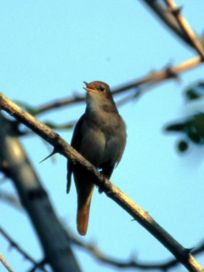Nightingale
2008/9 Schools Wikipedia Selection. Related subjects: Birds
| Nightingale | ||||||||||||||
|---|---|---|---|---|---|---|---|---|---|---|---|---|---|---|
 |
||||||||||||||
| Conservation status | ||||||||||||||
|
Least Concern
|
||||||||||||||
| Scientific classification | ||||||||||||||
|
||||||||||||||
| Binomial name | ||||||||||||||
| Luscinia megarhynchos ( Brehm, 1831) |
The Nightingale (Luscinia megarhynchos), also known as Rufous and Common Nightingale, is a small passerine bird that was formerly classed as a member of the thrush family Turdidae, but is now more generally considered to be an Old World flycatcher, Muscicapidae. It belongs to a group of more terrestrial species, often called chats.
It is a migratory insectivorous species breeding in forest and scrub in Europe and south-west Asia. The distribution is more southerly than the very closely related Thrush Nightingale Luscinia luscinia. It nests on the ground within or next to dense bushes. It winters in southern Africa. At least in the Rhineland (Germany) breeding habitat of nightingales is known to agree with a number of geographical parameters (Wink 1973):
- less than 200 meters above mean sea level
- mean air temperature during the growing season above 14°C
- more than 20 days/year on which temperatures exceed 25°C
- annual precipitation less than 750mm
- aridity index lower than 0.35
- no closed canopy.
The Nightingale is slightly larger than the European Robin, at 15-16.5 cm length. It is plain brown above except for the reddish tail. It is buff to white below. Sexes are similar.
Nightingales are named so because they frequently sing at night as well as during the day. The name has been used for well over 1,000 years, being highly recognizable even in its Anglo-Saxon form - 'nihtingale'. It means 'night songstress'. Early writers assumed the female sang; in fact, it is the male. The male nightingale is known for his singing, to the extent that human singers are sometimes admiringly referred to as nightingales; the song is loud, with an impressive range of whistles, trills and gurgles. Its song is particularly noticeable at night because few other birds are singing. This is why its name (in several languages) includes "night". Only unpaired males sing regularly at night, and nocturnal song is likely to serve attracting a mate. Singing at dawn, during the hour before sunrise, is assumed to be important in defending the bird's territory. Nightingales sing even more loudly in urban or near-urban environments, in order to overcome the background noise. The most characteristic feature of the song is a loud whistling crescendo, absent from the song of Thrush Nightingale. It has a frog-like alarm call.
The eastern subspecies L. m. hafizi and L. m. africana have paler upperparts and a stronger face-pattern, including a pale supercilium.
Culture
- The Nightingale is the national bird of Iran and Bangladesh.
- The love of the nightingale to the rose is also widely used, often metaphorically, in Turkish literature (especially in poems of the Ottoman period) as well as in Persian literature.
- John Keats' poem " Ode to a Nightingale" responds to the beauty of the nightingale's song.
- "Know Why the Nightingale Sings" is a song by Nightwish.
- " The Nightingale" is a poem by Samuel Taylor Coleridge.
- " The Frog and the Nightingale" is a poem by Vikram Seth.
- " The Nightingale" is a story by Hans Christian Andersen
- Le rossignol is an opera by Igor Stravinsky based on the Andersen tale. Stravinsky then adapted the opera into a symphonic poem called Le Chant du rossignol.
- The soprano Jenny Lind was nicknamed the Swedish Nightingale.
- In Oscar Wilde's short story " The Nightingale and the Rose", a Nightingale sacrifices itself to create a red rose for a student.
- Ottorino Respighi included a recording of the nightingale's song in the third movement of his symphonic poem The Pines of Rome.
- A Provençal folk song, " The Nightingale Which Flies", inspired Tchaikovsky when composing his Humoresque opus 10-2.
- A Nightingale Sang in Berkeley Square is the name of a popular song and film.
- " Bianca Among the Nightingales" is a poem by Elizabeth Barrett Browning
- "The Three Nightingales" was a vaudeville singing trio with the Groucho and Gummo Marx and Mabel O'Donnell.
- " Sweet Nightingale" is a Cornish folk song which probably dates from the Seventeenth Century, and is said to be a translation from the ancient Cornish language.
- " Persephone" has a song named " the Nightingale's Lament" .
- " Sarojini Devi Naidu" was referred to as " the Nightingale of India" for her melliflous voice.